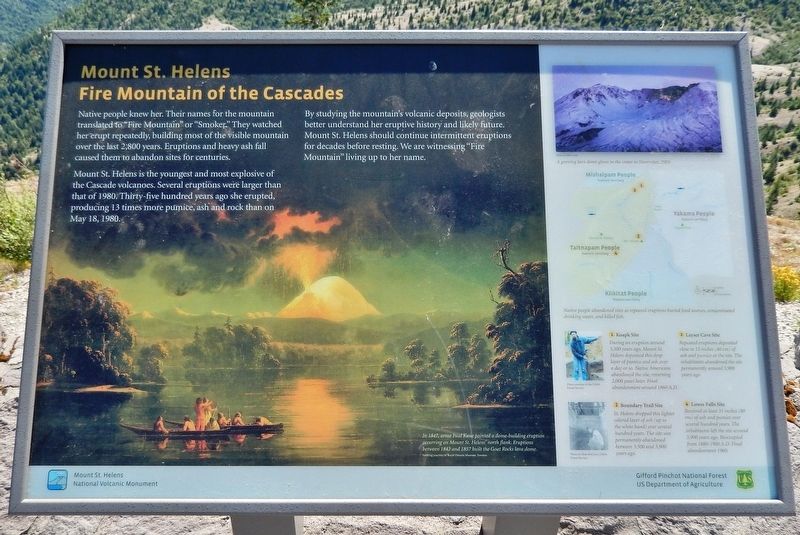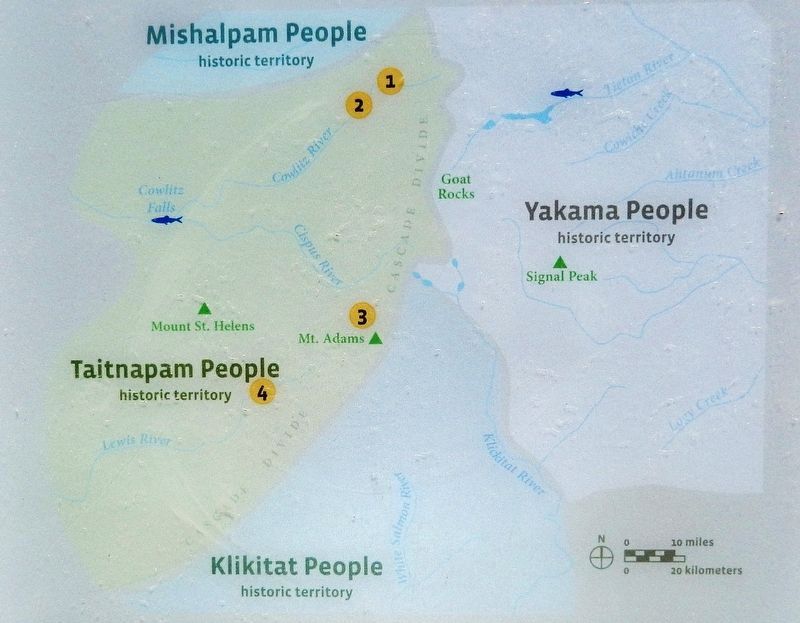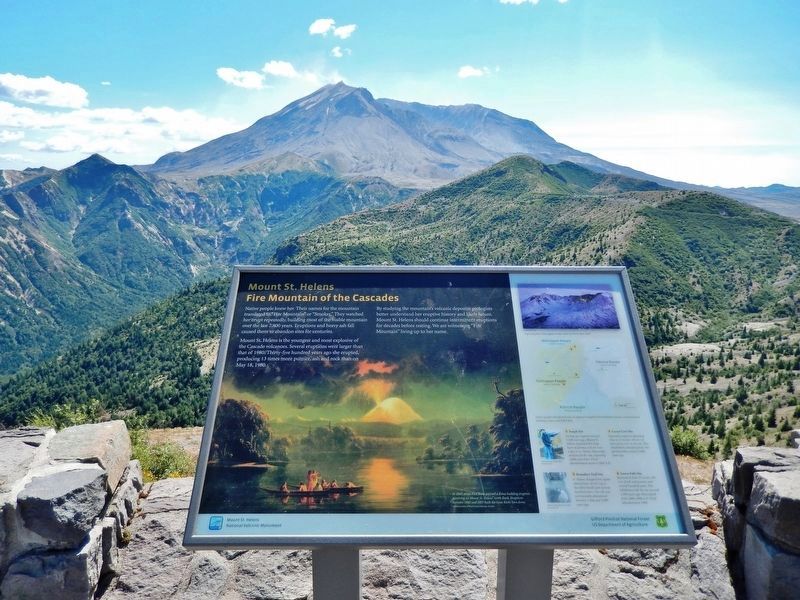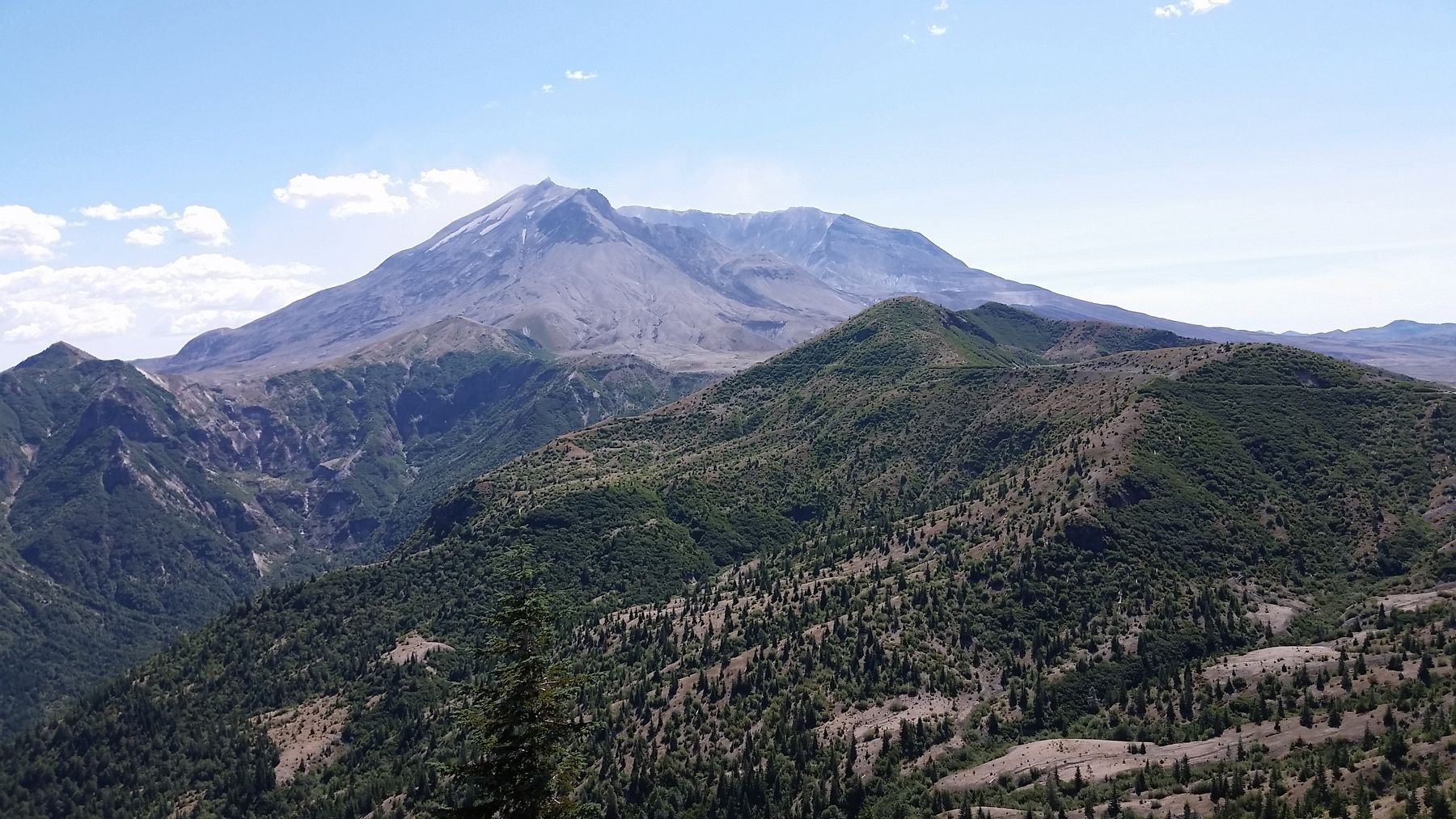Gifford Pinchot National Forest in Skamania County, Washington — The American West (Northwest)
Mount St. Helens
Fire Mountain of the Cascades
— Mount St. Helens National Volcanic Monument —
Native people knew her. Their names for the mountain translated to "Fire Mountain" or "Smoker." They watched her erupt repeatedly, building most of the visible mountain over the last 2,800 years. Eruptions and heavy ash fall caused them to abandon sites for centuries.
Mount St. Helens is the youngest and most explosive of the Cascade volcanoes. Several eruptions were larger than that of 1980. Thirty-five hundred years ago she erupted, producing 13 times more pumice, ash and rock than on May 18, 1980.
By studying the mountain's volcanic deposits, geologists better understand her eruptive history and likely future. Mount St. Helens should continue intermittent eruptions for decades before resting. We are witnessing "Fire Mountain" living up to her name.
1 • Koapk Site
During an eruption around 3,500 years ago, Mount St. Helens deposited this deep layer of pumice and ash over a day or so. Native Americans abandoned the site, returning 2,000 years later. Final abandonment around 1860 A.D.
2 • Layser Cave Site
Repeated eruptions deposited close to 15 inches (40 cm) of ash and pumice at the site. The inhabitants abandoned the site permanently around 3,900 years ago.
3 • Boundary Trail Site
St. Helens dropped this lighter colored layer of ash (up to the white band) over several hundred years. The site was permanently abandoned between 3,500 and 3,900 years ago.
4 • Lower Falls Site
Received at least 31 inches (80 cm) of ash and pumice over several hundred years. The inhabitants left the site around 3,900 years ago. Reoccupied from 1880-1900 A.D. Final abandonment 1960.
[background photo caption]
In 1847, artist Paul Kane painted a dome-building eruption occurring on Mount St. Helens’ north flank. Eruptions between 1842 and 1857 built the Goat Rocks lava dome.
Erected by Gifford Pinchot National Forest, US Department of Agriculture.
Topics. This historical marker is listed in these topic lists: Anthropology & Archaeology • Disasters • Native Americans • Science & Medicine. A significant historical date for this entry is May 18, 1980.
Location. 46° 15.137′ N, 122° 7.119′ W. Marker is in Gifford Pinchot National Forest, Washington, in Skamania County. Marker can be reached from Forest Road NF-99, 15 miles Forest Road NF-25. Marker is located at the Smith Creek Picnic Viewpoint in Mount St. Helens National Volcanic Monument. Touch for map. Marker is in this post office area: Cougar WA 98616, United States of America. Touch for directions.
Other nearby markers. At least 6 other markers are within 6 miles of this marker, measured as the crow flies. Hearts of Volcanoes Beat Beneath Peaceful Facades (a few steps from this marker);
The Pumice Plain (approx. 0.9 miles away); Survivors Create Spectacular Change (approx. 1.7 miles away); The Earth’s Monumental Power (approx. 4.6 miles away); Working with Nature to Rebuild an Ecosystem (approx. 4.6 miles away); More Than He Bargained For (approx. 5.8 miles away).
Also see . . .
1. Mount St. Helens History. History website entry:
According to the U.S. Geological Survey (USGS), Mount St. Helens began growing before the end of the Ice Age; its oldest ash deposits date to at least 40,000 years ago. Mount St. Helens had nine main eruptions prior to the 1980 eruption. Each “pulse” of eruptions lasted less than 100 years to up to 5,000 years, with long intervals of dormancy between them. (Submitted on October 31, 2020, by Cosmos Mariner of Cape Canaveral, Florida.)
2. Geology and History Summary for Mount St. Helens. USGS website entry:
It was only during the past few thousand years that the volcano grew to its pre-1980 elevation of 2,950m, making it the, then, fifth highest peak in Washington. Starting about 3,000 years ago, substantial amounts of basalt and andesite began to erupt as lava flows between phases of eruptive activity. These lava flows buried large parts of a central cluster of dacite domes and flanking fans, which started the cone building in earnest. (Submitted on October 31, 2020, by Cosmos Mariner of Cape Canaveral, Florida.)
3. Mount St. Helens. Information Resource Center website entry:
The local Indians and early settlers in the then sparsely populated region witnessed the occasional violent outbursts of Mount St. Helens. The volcano was particularly restless in the mid-19th century, when it was intermittently active for at least a 26-year span from 1831 to 1857. The mountain gave little or no evidence of being a volcanic hazard for more than a century after 1857. (Submitted on October 31, 2020, by Cosmos Mariner of Cape Canaveral, Florida.)
Credits. This page was last revised on January 10, 2024. It was originally submitted on October 30, 2020, by Cosmos Mariner of Cape Canaveral, Florida. This page has been viewed 220 times since then and 17 times this year. Photos: 1, 2, 3, 4, 5. submitted on October 31, 2020, by Cosmos Mariner of Cape Canaveral, Florida.




